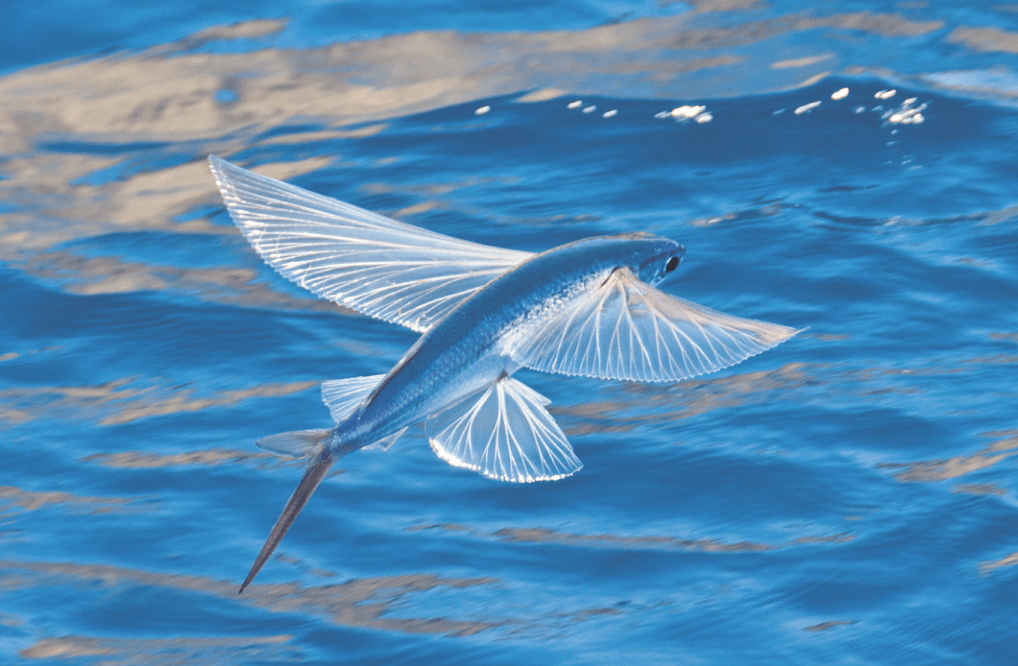
By Jim Knox
I was no more than five. The animal in the sand at my feet mesmerized me. While many things can mesmerize a small child, this was something that even the bigger kids and adults came over to see. They gathered, stared, and pointed. To my young mind the tiny creature was both familiar yet nonsensical. I stared at the slender blueish silver scaled creature laying just yards from the lapping waves of Nantucket Sound. It remember thinking it was a fish, but then quickly deciding that it must be a bird based on the “wings” nearly the length on its body. My dad—the solver of all mysteries—revealed the identity of the mystery creature. I remember him kneeling next to me so that we were the same height. He spoke with as much wonder as I felt.
“That’s a flying fish, son!” he shared.
I still remember looking at the sliver of a fish and thinking that my dad made perfect sense. After all, it did have “wings.” In time I would come to know this creature as the Atlantic Flying Fish, a species found from Massachusetts to Brazil. While not common at the northern end of their range, the species can be found in New England in certain years when the Gulf Stream eddies spin northward toward our shores.
While this is the only flying fish species in New England waters, there are 64 known species, the majority of which inhabit tropical and sub-tropical waters. Common features include a highly streamlined lance-shaped body, a forked tail with a longer lower lobe and, most conspicuously, a pair of elongate pectoral fins that resemble and function as wings. Among these 64 species are some which take the bird-like appearance to a new level.
The Four-Winged Flying Fish are a family of flying fish known as Exocoetidae. While their Two-Winged Flying Fish kin are known to “fly,” the Four-Winged species give that word new meaning. Though Flying Fish don’t truly fly, they are masterful gliders. With greatly enlarged pectoral fins as well as pelvic fins, these light fish have adopted a body plan which is more glider than grouper.
So why does a fish glide in the first place? Ichthyologists theorize that these creatures employ the ultimate escape plan—exploding from the water to escape aquatic predators such as Yellowfin Tuna, Wahoo, Swordfish, Mackerel and Marlin which cannot follow them in the air. Conversely, Flying Fish will tuck in their “wings” against their streamlined bodies to dart back down beneath the ocean’s surface to evade aerial predators such as acrobatic Frigate birds.
While the “why” is intriguing, the “how” is truly fascinating. So just how does a fish leave the ocean to go airborne for extended periods? That answer is found in the fish’s anatomical design. With light streamlined bodies averaging 7-12 inches, the fish’s shape reduces drag when gliding. Possessing reinforced bones in the spinal column, the Four-Winged Flying Fish can maintain a rigid posture for its aerial journeys, much like a glider requires a rigid airframe. Like the glider model, the fish has an expansive fin surface area and a low weight relative to this “wing surface” (its total fin surface area).
Yet even the best glider needs an assist to give it lift and set it on its way. That’s where the fish’s extraordinary design comes into play yet again. Sporting a lower tail lobe which is far longer than its upper counterpart, the Four-Winged Flying Fish can drive its tail along the water’s surface at a blurring rate of 70 beats per second. Acting like an outboard motor to drive the fish upward where it’s pectoral fins can catch lift off the updrafts generated by the waves, the fish launches upward, attaining speeds of 43 miles per hour and heights of up to 20 feet! What’s more, this “glider” can evade like no other, dropping down to the water’s surface, churning the surface furiously with its tail and taking “flight” again—in a different direction!
While these small creatures average glides of 160 feet (more than ½ a football field in distance), the record holder soared to new heights—launching aloft for an astounding 1,312 feet (nearly ¼ of a mile)! These long distance “flights” can last 45 seconds in duration. Such natural feats have not gone unnoticed by aeronautical engineers, as the unmatched aerial abilities of the Flying Fish inspired airplane design concepts in the 1920s and 1930s.
In the Four-Winged Flying Fish we have a creature which defies the conventional and gives us pause to reflect on what is truly possible. While nature continually amazes and inspires, it is a rare beast that lives among the waves yet journeys to the skies.
Jim Knox serves as the Curator of Education for Connecticut’s Beardsley Zoo and as a Science Adviser for The Bruce Museum. His passions include studying our planet’s rarest creatures and sharing his work with others who love the natural world.



